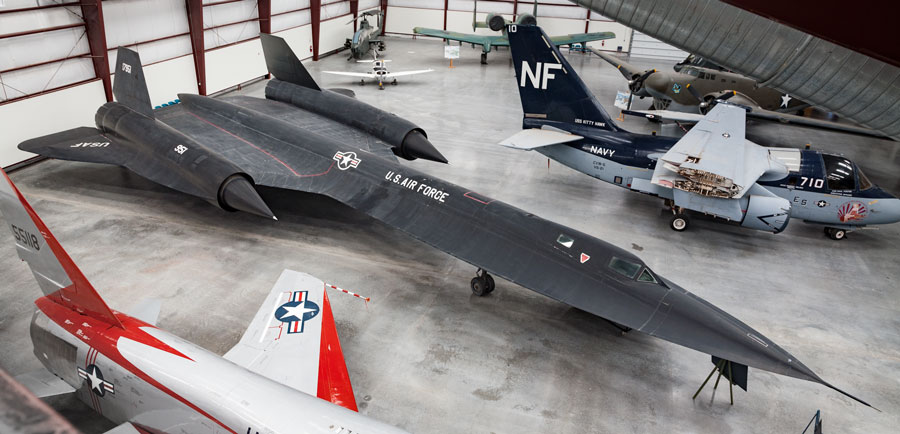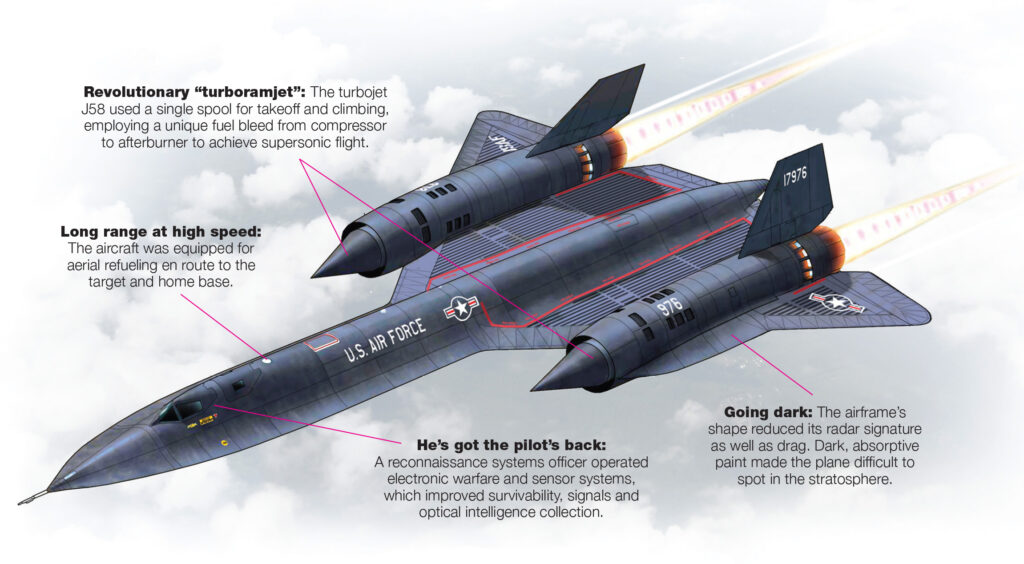The Lockheed SR-71 Corporation created the long-range, high-altitude, fast-moving, strategic Lockheed Martin SR-71 Blackbird. After taking off for the first time on December 22, 1964, the aircraft was presented to the USAF in January 1966. The Skunk Works division of Lockheed SR-71 Martin, a division devoted to the development of surveillance aircraft, designed and constructed the aircraft.

This aircraft could escape enemy threats and targets because of its ability to operate at very high altitudes. Detecting and avoiding surface-to-air missiles was another ability it had. Lockheed SR-71 produced a total of 32 aircraft. Not only did the USAF fly the type, but the National Aeronautics and Space Administration’s (NASA) 1999 saw the retirement of NASA’s aircraft, and 1998 marked the USAF’s. Since this class of aircraft is no longer in service, unmanned aerial vehicles (UAVs) and specialized satellites have assumed the reconnaissance role.
Over thirty years were spent providing vital services by the Lockheed SR-71. It was among the market’s most sought-after military mission aircraft. Even if some decommissioned aircraft are currently on display at museums, their operational prowess will be honored for many years to come. This essay from Simple Flying examines five of the SR-71 Blackbird’s most remarkable credentials.
01: Breaking speed records
The Lockheed SR-71 was intended to outperform all Soviet aircraft at the time in terms of speed. The goal of the Skunk Works crew was to go above 2,000 mph. The SR-71 was capable of flying at Mach 3.3 during its strategic missions, which was much faster than any of its rivals. The Lockheed SR-71 reached Mach 3.4 (2,300 mph, 3,650 km/h) on a test flight.
In slightly over an hour, it could complete a coast-to-coast flight across the United States. The aircraft broke the record for being the world’s fastest air-breathing manned aircraft in 1976. As of July 2023, the aircraft is still the record holder.
02: Extreme temperatures could not destroy the Lockheed SR-71 Blackbird.
This airplane was designed to outperform all other current models in terms of speed. The aircraft’s capacity to endure extremely high or low temperatures while in flight dictates its maximum speed requirement. The design team was forced to decide on titanium as the main component for the airplane. The front edges of the aircraft may reach temperatures of over a thousand degrees Fahrenheit, posing problems for material and design.
The best material was titanium, but it needed to be managed because it was brittle. The group created specific tools to be used in the titanium fabrication of the airplane. BBC News spoke with Colonel Rich Graham, a veteran Lockheed SR-71 pilot and 15-year wing commander. As stated by Graham,
All around, the aircraft is composed of 92% titanium. The United States lacked the necessary quantities of rutile ore when the airplane was being built. Only a small portion of the earth has this extremely sand-filled soil. The USSR was the main ore supply. By utilizing fake companies and Third World nations, they managed to arrange the shipment of rutile ore to the US for use in the construction of the
03: An authentic Lockheed SR-71
The aircraft’s structure must absorb the intense heat it encounters at very high speeds in order to avoid structural damage. Once more, air friction produces a tremendous amount of heat at speeds higher than Mach 3, especially at the aircraft’s front edges. The designers devoted numerous hours to come up with effective solutions for releasing heat while on a high-speed voyage.

The Lockheed SR-71 design team discovered during one of its design iterations that black effectively absorbs and dissipates heat. Because of this, the aircraft was painted completely black to effectively disperse heat while in flight. The Lockheed SR-71 was eventually dubbed the “Blackbird” because of its all-black color scheme.
04: Lockheed sr-71 blackbird altitude
The aircraft, as previously stated, was designed to fly at much higher altitudes than those of current Soviet Union aircraft. One of the most important limitations of this Cold War design was having a substantially greater service ceiling. The aircraft’s amazing altitude of 80,000 feet (24,400 meters) was far higher than that of the majority of warplanes operating at the time.
At those heights, air density is incredibly low, which helps one reach higher speeds. To endure the pressures of high altitude, the Lockheed SR-71 pilots had to don specialized pressure suits, which are akin to space suits worn by astronauts. The aircraft was also able to avoid radar detection and some types of missiles by flying at high altitudes.
05: The aircraft might be able to dodge surface-to-air missiles.
The Lockheed SR-71’s speed helped it avoid enemy surface-to-air missiles. It moved so quickly that it was too late to launch when a surface-to-air missile managed to track the SR-71 and place it on target. The SR-71 would be well out of range before the missile exploded, even if it were launched.
The pilots frequently witnessed surface-to-air missiles detonating miles from where they were at the time. Additionally, the low radar cross-section of the aircraft—which the designers purposefully kept low to deceive the enemy—made it possible. The Lockheed SR-71 would appear smaller than a six-foot human during radar testing.
 LivemintUSA All the news in one place
LivemintUSA All the news in one place



